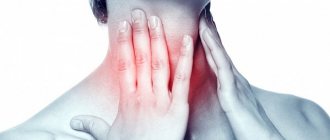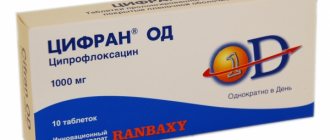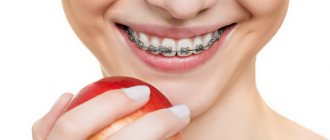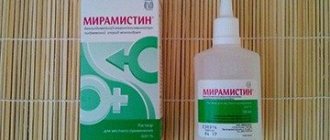Diseases of the oral cavity and nasopharynx are a common occurrence in the practice of therapists, pediatricians and some specialized specialists (otolaryngologists, dentists, infectious disease specialists). Their occurrence may be associated with airborne and sexually transmitted infections, complications of surgical operations, hypothermia and other factors.
Antiseptics, analgesics and anti-inflammatory drugs are used in the treatment of dental and otolaryngological pathologies. Miramistin and Tantum Verde have a complex effect and are often prescribed for treating the oral cavity and irrigating the throat.
Characteristics of Miramistin
The drug Miramistin, containing the active substance of the same name, affects the outer membrane of the cells of bacteria, fungi and other microbes. This leads to complete destruction of the membrane and death of the microorganism. In addition to the bactericidal effect, Miramistin stimulates tissue restoration and healing of microtraumas in the area of application, activates local immune reactions and relieves inflammation.
Miramistin is a drug that stimulates tissue restoration and healing of microtraumas in the area of application.
The antiseptic properties of the drug apply to staphylococcal and streptococcal flora (including pneumococci), Klebsiella, Escherichia coli, pathogenic fungi, pseudomonas, STI pathogens (chlamydia, gonorrhea, trichomoniasis, syphilis) and some viruses (HIV, herpesviruses, measles virus, etc.).
The action of Miramistin is manifested incl. in relation to microbial associations, hospital strains of bacteria insensitive to antibiotics, and fungi resistant to chemotherapeutic drugs.
The antiseptic interacts well with local antimycotics and antibiotics: when Miramistin is used together with drugs from these groups, their effectiveness increases.
Indications for the use of Miramistin are:
- infectious and inflammatory diseases of the respiratory tract (otitis, tonsillitis, laryngitis, acute pharyngitis, tonsillitis, etc.);
- inflammation of the gums and oral cavity (stomatitis, periodontitis, gingivitis, etc.);
- prevention of infectious complications of operations and dental procedures;
- skin treatment for tissue trophic disorders due to diabetes mellitus (diabetic foot);
- purulent inflammation of the musculoskeletal system, skin and mucous membranes;
- prevention of STIs after unprotected sexual intercourse;
- inflammation of the female reproductive system (vaginitis, endometritis), trauma and birth damage to the vagina;
- urethritis, urethroprostatitis;
- preparation of burned tissues for skin transplantation;
- treatment of fistulas, burns, wounds and other damage to the skin;
- oral hygiene, removable and non-removable dental implants.
Depending on the indications, Miramistin is prescribed in the form of a solution or ointment with a concentration of the active ingredient of 0.01% and 0.5%. A solution of the drug is used for irrigation and gargling, treatment of the oral cavity, mucous membranes and skin lesions.
When Miramistin is applied to the skin and mucous membranes, side effects may occur: a slight burning sensation that stops after 20-30 seconds, or more severe allergic reactions. A short-term burning sensation does not require cessation of therapy.
Contraindications to treatment with Miramistin are individual sensitivity to the drug and age under 3 years. There are no data on the safety of the drug during breastfeeding, so it is prescribed to lactating women with caution.
Which product can you trust?
When assessing the effectiveness of drugs, we focus on Russian-language and foreign sources. An important selection criterion is the availability of full-fledged clinical trials for a specific drug. According to accepted international standards, a drug that can be trusted must undergo randomized, double-blind, placebo-controlled studies. With this method, neither the doctor nor the patient knows whether it is a medicine or a pacifier. Distribution into groups occurs randomly; this parameter cannot be influenced. This tactic allows you to understand whether the drug works, evaluate its effectiveness - and be confident that the results are reliable.
Hexoral
Let's see what they write about the drug:
- In 2005, a comparative analysis of the effectiveness of hexethidine, another antiseptic chlorhexidine and placebo was carried out. It turned out that there are no significant differences between these components, and both of them are better than a pacifier.
- Later in 2005, a scientific review was presented where the authors examined all the studies on hexethidine. A total of 168 articles were submitted on this topic, but only a portion of them met the criteria (that is, they were randomized, double-blind, placebo-controlled). The analysis showed that hesetidine copes well with its task - relieves pain, inflammation, and acts against pathogenic microorganisms.
- Hexethidine has proven itself to be an effective remedy for diseases of the oral cavity. In other work, the drug also dealt with viruses, bacteria and fungi of the oral cavity. But there were only a few participants here, and one must be guided by this result with caution.
- Hexethidine is stated in foreign literature as a means of preventing postoperative infectious complications in dentistry. The authors of the study showed that with the use of the drug, complications after periodontal intervention (the tissue around the tooth) occurred less frequently.
- Hexethidine does not always inhibit the growth of pathogenic microorganisms. In one study, scientists spoke negatively about the drug. They proved that the drug is ineffective for chronic stomatitis.
- The Russian-language literature contains many articles devoted to the use of Hexoral in children. In one of them, the authors point out: with acute tonsillitis and pharyngitis, the symptoms of the disease go away faster, and complications arise less often.
At an international scientific conference in 2021, Hexoral was announced as the best option for upper respiratory tract infections.
Tantum verde
The PubMed database contains about 50 studies on the drug, but most of them are not available - they were conducted in the last century. Here's what they write in new sources:
- Benzidamine has shown its effectiveness in the treatment of tonsillopharyngitis caused by streptococcus. The study met all the criteria, but only 149 people participated. The authors write that in combination with antibiotics, benzydamine improves the course of the disease.
- Another serious study on antiseptics shows that benzydamine leads to a decrease in symptoms on the 3-7th day of illness. It is well tolerated and causes virtually no side effects.
- The drug is used to prevent complications after removal of the tonsils, but its effect remains questionable. One study found that benzydamine quickly relieved pain, swelling, and redness in the throat. Other scientists say: there is no improvement. Experts from the Cochrane Library also had their say. A review from 2013 stated that it is too early to draw conclusions - the quality of the reports is low, and it is impossible to speak unequivocally about the effectiveness of the drug.
- In Russian-language literature, Tantum Verde is presented as a drug with a pronounced clinical effect. It is recommended for infectious and inflammatory diseases of the oropharynx of various origins.
- In 2013, a comparative analysis of five drugs for sore throat was carried out in Moscow. The list includes Hexoral and Tantum Verde. The authors did not find any significant differences between them:
- With the use of Tantum Verde, recovery was noted in 60% of patients. 10% showed significant improvement. In 30% of cases there was no effect, and the drug had to be replaced.
- When using Hexoral, 55% of patients recovered, 15% showed significant improvement. In 30% of cases there was no effect.
The study involved patients 18-60 years old with diseases of the pharyngeal mucosa (acute and chronic tonsillitis, tonsillopharyngitis), with sore throat due to ARVI.
How does Tantum Verde work?
Tantum Verde exhibits antiseptic, anti-inflammatory and mild analgesic properties. The active component of the drug is benzydamine, which is able to penetrate the cell membrane and damage important microbial structures that directly affect the rate of growth and reproduction of pathogens.
Tantum Verde is a drug with antiseptic, anti-inflammatory and moderate analgesic effects.
The analgesic effect is associated with the membrane-stabilizing and anti-inflammatory effects of the drug. It has been established that benzydamine has approximately 50% of the local anesthetic potential of tetracaine, which is used for superficial surgical interventions. The average duration of pain relief when applying the drug is 1.5 hours.
The antimicrobial effect of the drug extends to aerobic and anaerobic pathogens, incl. staphylococci, streptococci and antimycotic-resistant strains of Candida fungi, which often cause infections of the ENT organs and oral cavity.
The use of this antiseptic is indicated for the following pathologies:
- infections of the oral mucosa (gingivitis, periodontitis, glossitis, etc.);
- candidal stomatitis of the oral cavity (in combination with systemic antimycotics);
- infectious and non-infectious inflammatory processes in the ENT organs (tonsillitis, acute and indolent pharyngitis, laryngitis);
- periodontal disease;
- calculous sialadenitis (inflammation of the salivary gland).
Periodontal disease is one of the indications for the use of Tantum Verde.
The drug is also prescribed to prevent bacterial complications from operations in the oral cavity, dental procedures, injuries of the jaw and face.
The medicine is presented in 3 forms of release: a solution for rinsing the mouth and throat, tablets and an aerosol. The concentration of the active substance in the solution is 0.15%, and its dosage in 1 tablet or spray is 3 mg and 0.255 mg.
When using the medicine according to the instructions, local adverse reactions may occur (dryness, numbness of the oral cavity, burning at the site of application).
The appearance of a rash indicates the development of an allergy and the need to change the drug.
For patients with a tendency to allergic reactions and bronchial asthma, drugs with benzydamine are prescribed with caution due to the risk of broncho- and laryngospasm.
Contraindications to drug therapy are:
- allergies to substances present in the aerosol, tablets and solution (including phenylketonuria and fructose intolerance);
- children's age (up to 3 years - for aerosol, up to 6 years - for tablets, up to 12 years - for solution).
Content:
- Effects of pentobarbital
- Overdose prevalence
- Risk factors
- Overdose symptoms
- Complications
- Causes of death
- First aid
- Specialized treatment
Pentobarbital sodium is a drug from the group of barbiturates. It has a rapid hypnotic effect, the effect begins within 15–35 minutes after administration and lasts for approximately 6 hours. In Russia it is included in the list of medicines with restricted circulation. Illegally used to achieve a state of drug intoxication. Sometimes used to commit suicide attempts.
Comparison of Miramistin and Tantum Verde
Despite a number of similar indications for use, these drugs are not analogues and do not have common components in their composition. For bacterial infections of the pharynx and oral cavity, the combined use of both drugs may be prescribed.
Similarities
In addition to the indications for use, the drugs are similar in the specifics of their effects (the presence of an antiseptic effect), side effects (in both cases, a burning sensation in the mucous membrane is possible after use) and safety for vulnerable groups of patients (both drugs are allowed to be used during pregnancy and childhood).
What is the difference
The difference between the two means is observed in the following aspects:
- mechanism of action;
- release form of the drug;
- range of applications in various fields of medicine.
Which is cheaper?
The price of Miramistin (150 ml bottle of solution) starts from 385 rubles. The cost of Tantum Verde starts from 229 rubles (for aerosol), 278 rubles (for solution) or 234 rubles (for tablets).
Taking into account the recommended duration of treatment and therapeutic dose of drugs, Miramistin is a more expensive drug.
conclusions
Briefly about the important:
- Tantum verde and Hexoral are indicated for topical use for diseases of the oral cavity and larynx. They relieve pain, swelling and inflammation, and alleviate the course of the disease.
- Both drugs have undergone clinical trials and proven effective.
- Both drugs are well tolerated and rarely cause adverse reactions.
- Tantum verde and Hexoral are prescribed to adults and children from 3 years of age. Hexoral can also be used during pregnancy and lactation, but only in consultation with your doctor.
When choosing a drug, remember: spray and aerosol cannot always cope with the infection alone. It is often necessary to add other serious medications – antibiotics and systemic antivirals. Don't be confused by the fact that Tantum Verde and Hexoral are available without a prescription - you can't do it without consulting a doctor.
Which is better: Miramistin or Tantum Verde
Both antiseptics have their own advantages, which determine their preferred use for various indications.
Miramistin has a wider spectrum of action and high antimicrobial activity. It is used in various fields of medicine, so it is a universal remedy for a home medicine cabinet. In addition, this drug enhances the effect of more effective antibacterial and antifungal agents. Treatment with Miramistin is recommended for bacterial infections, incl. provoked by STIs, hospital and atypical microflora.
Compared to Tantum Verde, Miramistin has a wider spectrum of action and high antimicrobial activity.
The activity of Tantum Verde as an antiseptic is lower than that of Miramistin, but it has a good anti-inflammatory and analgesic effect. The drug is prescribed for severe pain in the area of inflammation (throat, tongue, larynx, gums, etc.) and viral etiology of infection. All 3 forms of release of the product are convenient for the treatment of diseases of the throat and oral cavity.
The choice of Miramistin or Tantum Verde for treatment, as well as the decision to replace the drug, should be made by the attending physician, who takes into account the results of laboratory and instrumental studies, complaints and medical history of the patient.
For children
Both drugs are safe for patients over 3 years of age.
For children under this age, these antiseptics are prescribed according to strict indications and under the supervision of a doctor.
Fight against viruses and bacteria: how they work
Hexoral and Tantum verde are deservedly popular among medical practitioners. But the scope of application of these funds differs slightly. To understand when aerosols and sprays are prescribed, you need to know the principles of their operation. Next we looked at how the drugs work.
Hexoral
Hexethidine is an antiseptic for topical use. It has a moderate antimicrobial effect - it destroys pathogenic microorganisms and prevents their reproduction. Once on the mucous membranes, Hexoral penetrates the cell wall of bacteria and suppresses some oxidative reactions. Hexethidine acts as a thiamine antagonist and affects key components of microbial metabolism.
How does he work:
- Antibacterial action. Hexoral is a broad-spectrum antiseptic. It destroys many gram-negative and gram-positive bacteria and has a detrimental effect against the most common pathogens of throat and nose diseases.
- Antifungal action. Fungi of the genus Candida are sensitive to the action of hexethidine. They often act as a secondary infection - as a complication after infection with viruses and bacteria.
- Antiviral effect. Hexoral is effective against influenza virus type A, RS virus, and herpes simplex virus type 1. These viruses are more often detected when the respiratory tract is affected.
- Anesthetic effect. The aerosol relieves sore throat and alleviates the patient's condition.
- Drug resistance to Hexoral has not yet been identified. All declared viruses, fungi and bacteria are sensitive to the effects of the drug.
Hexethidine is practically not absorbed, does not penetrate deep into tissues and does not enter the systemic circulation. It acts only locally – where help is needed. After a single application, traces of the substance are detectable on the gum mucosa for 65 hours (but only 14 hours in the presence of plaque).
Tantum verde
The mechanism of action of benzydamine is not fully understood. It belongs to the NSAIDs, but does not act in the same way as the usual Paracetamol or Nurofen. Typically, drugs in this group suppress the activity of the COX enzyme, inhibit the production of prostaglandins and eliminate the inflammatory process. Benzidamine works differently. It does not affect cycloxygenases, and therefore does not have the usual side effects of NSAIDs.
Mechanism of action of Tantum verde:
- Anti-inflammatory effect. It is assumed that benzydamine inhibits the activity of prostaglandin synthetase, an enzyme that is involved in the synthesis of prostaglandins and the initiation of the inflammatory response.
- Antibacterial action. Benzidamine quickly penetrates the cell wall of bacteria, disrupts metabolic processes and leads to the death of microorganisms.
- Antifungal action. The drug is effective against Candida albicans. It leads to structural changes in the cell wall of fungi and prevents their reproduction.
- Local anesthetic effect. Benzydamine relieves sore throat and relieves the condition.
When applied topically, the drug is quickly absorbed and penetrates the tissues. A small amount of benzydamine is found in the bloodstream, but this is not enough to produce systemic effects. It is excreted mainly by the kidneys in the form of inactive substances.
Patient reviews
Tatyana, 33 years old, Minsk
Miramistin is the best drug for protecting against infections and preventing suppuration of wounds. I treat any damage on the skin of children only with it, because... it is quite effective and does not cause discomfort, like iodine or peroxide.
Miramistin is convenient to use for throat inflammation: it quickly brings relief and does not have any chemical aftertaste.
The medicine is completely worth its cost.
Olga, 21 years old, Tomsk
For another pharyngitis, the therapist prescribed Tantum Verde. After reading the reviews, I was skeptical, but decided to follow the doctor’s recommendation. I was pleased with the drug: it instantly relieved all the unpleasant symptoms, allowed me to eat calmly for the first time in all the days of my illness, and softened my throat.
It is necessary to clarify that this medicine is not exactly the same as other antiseptics: its active ingredient is more of an anti-inflammatory agent, therefore it helps well with pain.
Overdose prevalence
Poisoning with drugs belonging to the group of barbiturates is diagnosed in almost a quarter of patients admitted to specialized toxicology centers. Fatal overdoses reach 3% in the structure of mortality from intoxication . These statistics take into account not only pentobarbital, but also other barbituric acid-based drugs. However, the data looks alarming and indicates the high danger of taking the drug for the purpose of drug intoxication.
Risk factors
Most often, a pentobarbital overdose is diagnosed under the following circumstances:
- inappropriate use of medication (to achieve euphoria);
- combination with the use of alcoholic beverages;
- self-administration without a doctor’s prescription or as prescribed by a specialist, but not in accordance with the recommendations (changes in dosage and frequency of administration).
The risk group includes people with social adaptation disorders, neurotic disorders, and alcoholism. When taken over a long period of time, barbiturates cause addiction. Over time, tolerance occurs - previous doses no longer produce the desired effect, which entails the need to increase dosages and, as a result, increase the likelihood of poisoning.











